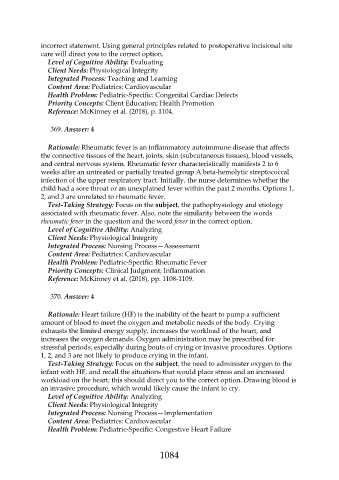Page 1084 - Saunders Comprehensive Review For NCLEX-RN
P. 1084
incorrect statement. Using general principles related to postoperative incisional site
care will direct you to the correct option.
Level of Cognitive Ability: Evaluating
Client Needs: Physiological Integrity
Integrated Process: Teaching and Learning
Content Area: Pediatrics: Cardiovascular
Health Problem: Pediatric-Specific: Congenital Cardiac Defects
Priority Concepts: Client Education; Health Promotion
Reference: McKinney et al. (2018), p. 1104.
369. Answer: 4
Rationale: Rheumatic fever is an inflammatory autoimmune disease that affects
the connective tissues of the heart, joints, skin (subcutaneous tissues), blood vessels,
and central nervous system. Rheumatic fever characteristically manifests 2 to 6
weeks after an untreated or partially treated group A beta-hemolytic streptococcal
infection of the upper respiratory tract. Initially, the nurse determines whether the
child had a sore throat or an unexplained fever within the past 2 months. Options 1,
2, and 3 are unrelated to rheumatic fever.
Test-Taking Strategy: Focus on the subject, the pathophysiology and etiology
associated with rheumatic fever. Also, note the similarity between the words
rheumatic fever in the question and the word fever in the correct option.
Level of Cognitive Ability: Analyzing
Client Needs: Physiological Integrity
Integrated Process: Nursing Process—Assessment
Content Area: Pediatrics: Cardiovascular
Health Problem: Pediatric-Specific: Rheumatic Fever
Priority Concepts: Clinical Judgment; Inflammation
Reference: McKinney et al. (2018), pp. 1108-1109.
370. Answer: 4
Rationale: Heart failure (HF) is the inability of the heart to pump a sufficient
amount of blood to meet the oxygen and metabolic needs of the body. Crying
exhausts the limited energy supply, increases the workload of the heart, and
increases the oxygen demands. Oxygen administration may be prescribed for
stressful periods, especially during bouts of crying or invasive procedures. Options
1, 2, and 3 are not likely to produce crying in the infant.
Test-Taking Strategy: Focus on the subject, the need to administer oxygen to the
infant with HF, and recall the situations that would place stress and an increased
workload on the heart; this should direct you to the correct option. Drawing blood is
an invasive procedure, which would likely cause the infant to cry.
Level of Cognitive Ability: Analyzing
Client Needs: Physiological Integrity
Integrated Process: Nursing Process—Implementation
Content Area: Pediatrics: Cardiovascular
Health Problem: Pediatric-Specific: Congestive Heart Failure
1084

